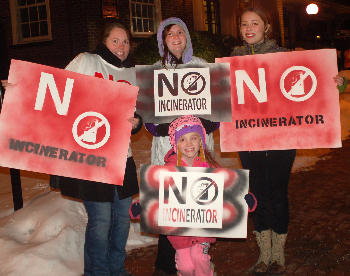- by Ann Darling, The Safe and Green Campaign
[[{"type":"media","view_mode":"media_large","fid":"230","attributes":{"alt":"","class":"media-image","style":"width: 288px; height: 229px; margin: 3px 10px; float: left;"}}]]The Vermont Yankee nuclear power station in southeastern Vermont will close in December of this year after operating for over 40 years. The owner, Entergy Nuclear, is based in New Orleans and is the second largest nuclear power company in the U.S.
As a member of the Safe and Green Campaign, which is made up of activists who live close to the nuke and whose homeland is the most in harm’s way, I have witnessed some pretty dirty tactics to keep this particular form of dirty energy going. The litany of problems and deceit seemed never to end – a transformer fire, rotted cooling towers flooding the site with water, tritium leaks, lies under oath, multiple lawsuits, regulatory complicity and deafness, the silencing of the Vermont legislature, state inaction on the heating of the Connecticut River, bargaining in back rooms with the Governor to make a deal with an acknowledged devil (Entergy), the challenge to democracy embodied in federal law that says only “experts” can understand or address nuclear safety issues. And that’s not all, by far.
But now Vermont Yankee is closing. Music to my ears? Well, for a few moments we celebrated. We celebrated our role in supporting the State of Vermont to enact legislation to take some control back for the state, and in the ultimately unsuccessful lawsuit between Entergy and Vermont. We celebrated the organizing of many meaningful and fun actions that mobilized thousands. We celebrated not having to go to any more Nuclear Regulatory Commission hearings that just left us angry and incredulous (I have to admit I enjoyed scolding the young NRC staffer about not cleaning up after himself and leaving all the radioactive waste in an incredibly vulnerable pool of water.)
Yankee said it closed because it was no longer profitable to operate due to the cheap cost of natural gas. OK, I can accept that. And I also know that the millions of dollars Entergy had to spend on lawsuits and security, and the bad press they got, also played an important role that we are very proud of.
But now back to reality. Yankee has been a large employer in our rural area, and it has paid very high salaries and supported lots of local non-profits. Its closing will have a major impact on a local economy that is already weak. Entergy has promised $10 million over five years for economic development, and there are a lot of competing ideas for that money. The Safe and Green Campaign, among others, will be here to watchdog the decommissioning process, and two of our members have been nominated to a state panel that will be closely involved in overseeing that.
People are scared. Fear can make it hard to think through things well. They are scared about what’s going to happen with property values and small businesses already hanging on by a very thin thread. They have a fundamental disquiet with developing many small power generating facilities that use solar and wind. They believe they need big facilities to generate enough power. And they don’t seem to really take conservation and efficiency seriously.
Now there’s a proposal to use the VY site for biomass with a tie in to a natural gas pipeline that’s trying to go through just south in Massachusetts. Lots of people are jumping at this like it’s actually the answer to everything. (Remember what I said about what being scared does to us?) After all, there are heavy duty transmission lines there, a railroad running right by the front gates, a well-established lumber industry, a river, an interstate. For four decades we’ve been living with the insanity of boiling water with radioactivity to generate electricity. We don’t think replacing that by burning biomass and emitting particulates and greenhouse gases, pressuring our beautiful forests, and burning more fracked gas makes any more sense than nuclear. As my friend Leslie said, “Bye-bye locally grown, truly green energy development. Hello, huge facility owned by yet another conglomerate of corporate investors.”
The Safe and Green Campaign has always had to emphasize the “safe” part of our work because we have been living under the pall of catastrophe for so long. But our banner doesn’t have a “No Nukes” symbol on it. It has an iconic picture of the sun’s glorious rays, and we need to shift our balance more and more to the “green” part of our work. Now we need to educate ourselves even more about all the ways to produce sustainable energy, and tap into our allies who helped create Vermont’s progressive plan for developing renewable energy. We need to be able to make sense to the people who are scared, with good reason, about our communities’ survival. We have been reaching out to the local 350.org group and others, and that’s good. We need to keep reaching out and take it as far up and across the power “food chain” as we can. This isn’t a “one site at a time” issue. It’s a national and international travesty that will send us to climate catastrophe if we don’t all work together.

 This is the year for victories against biomass and waste incinerators. We've tracked
This is the year for victories against biomass and waste incinerators. We've tracked 
